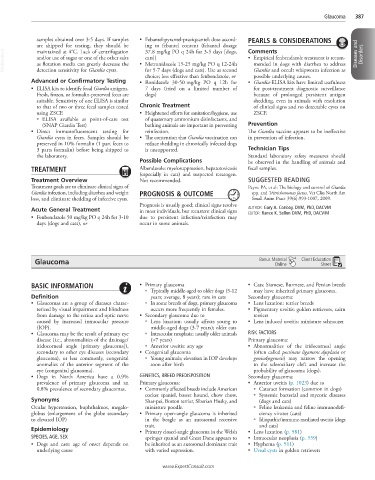Page 817 - Cote clinical veterinary advisor dogs and cats 4th
P. 817
Glaucoma 387
samples obtained over 3-5 days. If samples • Febantel-pyrantel-praziquantel: dose accord- PEARLS & CONSIDERATIONS
are shipped for testing, they should be ing to febantel content (febantel dosage Comments
VetBooks.ir and/or use of sugar or one of the other salts • Metronidazole 15-25 mg/kg PO q 12-24h • Empirical fenbendazole treatment is recom- Diseases and Disorders
37.8 mg/kg PO q 24h for 3-5 days [dogs,
maintained at 4°C. Lack of centrifugation
cats])
mended in dogs with diarrhea to address
as flotation media can greatly decrease the
detection sensitivity for Giardia cysts.
for 5-7 days (dogs and cats). Use as second
choice; less effective than fenbendazole, or Giardia and occult whipworm infection as
possible underlying causes.
Advanced or Confirmatory Testing • Ronidazole 30-50 mg/kg PO q 12h for • Giardia-ELISA kits have limited usefulness
• ELISA kits to identify fecal Giardia antigens. 7 days (tried on a limited number of for post-treatment diagnostic surveillance
Fresh, frozen, or formalin-preserved feces are dogs) because of prolonged persistent antigen
suitable. Sensitivity of one ELISA is similar shedding, even in animals with resolution
to that of two or three fecal samples tested Chronic Treatment of clinical signs and no detectable cysts on
using ZSCF. • Heightened efforts for sanitation/hygiene, use ZSCF.
○ ELISA available as point-of-care test of quaternary ammonium disinfectants, and
(SNAP Giardia Test) bathing animals are important in preventing Prevention
• Direct immunofluorescent testing for reinfection. The Giardia vaccine appears to be ineffective
Giardia cysts in feces. Samples should be • The contention that Giardia vaccination can in prevention of infection.
preserved in 10% formalin (1 part feces to reduce shedding in chronically infected dogs
3 parts formalin) before being shipped to is unsupported. Technician Tips
the laboratory. Standard laboratory safety measures should
Possible Complications be observed in the handling of animals and
TREATMENT Albendazole: myelosuppression, hepatotoxicosis fecal samples.
(especially in cats) and suspected teratogen.
Treatment Overview Not recommended. SUGGESTED READING
Treatment goals are to eliminate clinical signs of Payne PA, et al: The biology and control of Giardia
Giardia infection, including diarrhea and weight PROGNOSIS & OUTCOME spp. and Tritrichomonas foetus. Vet Clin North Am
loss, and eliminate shedding of infective cysts. Small Anim Pract 39(6):993-1007, 2009.
Prognosis is usually good; clinical signs resolve
Acute General Treatment in most individuals, but recurrent clinical signs AUTHOR: Gary A. Conboy, DVM, PhD, DACVM
• Fenbendazole 50 mg/kg PO q 24h for 3-10 due to persistent infection/reinfection may EDITOR: Rance K. Sellon DVM, PhD, DACVIM
days (dogs and cats), or occur in some animals.
Glaucoma Bonus Material Client Education
Online
Sheet
BASIC INFORMATION • Primary glaucoma • Cats: Siamese, Burmese, and Persian breeds
○ Typically middle-aged to older dogs (3-12 may have inherited primary glaucoma.
Definition years; average, 8 years); rare in cats Secondary glaucoma:
• Glaucomas are a group of diseases charac- ○ In some breeds of dogs, primary glaucoma • Lens luxation: terrier breeds
terized by visual impairment and blindness occurs more frequently in females. • Pigmentary uveitis: golden retrievers, cairn
from damage to the retina and optic nerve • Secondary glaucoma due to terriers
caused by increased intraocular pressure ○ Lens luxation: usually affects young to • Lens induced uveitis: miniature schnauzer
(IOP). middle-aged dogs (3-7 years); older cats
• Glaucoma may be the result of primary eye ○ Intraocular neoplasia: usually older animals RISK FACTORS
disease (i.e., abnormalities of the drainage/ (>7 years) Primary glaucoma:
iridocorneal angle [primary glaucoma]), ○ Anterior uveitis: any age • Abnormalities of the iridocorneal angle
secondary to other eye diseases (secondary • Congenital glaucoma (often called pectinate ligament dysplasia or
glaucoma), or less commonly, congenital ○ Young animals; elevation in IOP develops goniodysgenesis) may narrow the opening
anomalies of the anterior segment of the soon after birth to the sclerociliary cleft and increase the
eye (congenital glaucoma). probability of glaucoma (dogs).
• Dogs in North America have a 0.9% GENETICS, BREED PREDISPOSITION Secondary glaucoma:
prevalence of primary glaucoma and an Primary glaucoma: • Anterior uveitis (p. 1023) due to
0.8% prevalence of secondary glaucomas. • Commonly affected breeds include American ○ Cataract formation (common in dogs)
cocker spaniel, basset hound, chow chow, ○ Systemic bacterial and mycotic diseases
Synonyms Shar-pei, Boston terrier, Siberian Husky, and (dogs and cats)
Ocular hypertension, buphthalmos, megalo- miniature poodle. ○ Feline leukemia and feline immunodefi-
globus (enlargement of the globe secondary • Primary open-angle glaucoma is inherited ciency viruses (cats)
to elevated IOP) in the beagle as an autosomal recessive ○ Idiopathic/immune-mediated uveitis (dogs
trait. and cats)
Epidemiology • Primary closed-angle glaucoma in the Welsh • Lens luxation (p. 581)
SPECIES, AGE, SEX springer spaniel and Great Dane appears to • Intraocular neoplasia (p. 559)
• Dogs and cats: age of onset depends on be inherited as an autosomal dominant trait • Hyphema (p. 511)
underlying cause with varied expression. • Uveal cysts in golden retrievers
www.ExpertConsult.com

